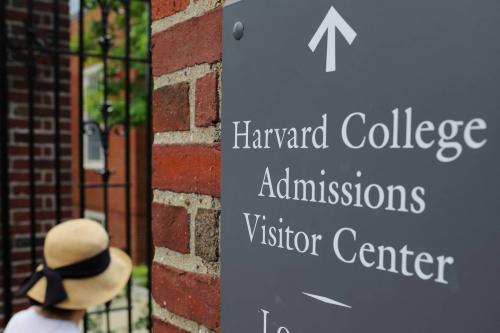This paper was prepared for the June 18, 2020, conference on Automation, Training, and the Middle Class for the Brookings Institution, Future of the Middle Class Initiative.
Abstract
Deciding which field to study is one of the most consequential decisions college students make, but most research on the topic focuses on students attending four-year colleges. To understand how students attending community colleges make field of study decisions, I link administrative educational records of recent high school graduates with local mass layoff and plant closing announcements. I find that declines in local employment deter students from entering closely related community college programs and instead induce them to enroll in other vocationally-oriented programs. I further document that students predominantly shift enrollment between programs that lead to occupations requiring similar skills.
Introduction
The educational decisions that young people make can substantially affect their long-run labor market outcomes and overall economic well-being. The typical college graduate will earn more than double the typical high school graduate over her lifetime, while also experiencing improved health, less reliance on social safety net programs, and fewer interactions with the criminal justice system. Equally large earnings gaps exist among students with the same level of education who pursue different fields of study, and a growing body of literature shows that students take these earnings gaps into account when selecting college majors, particularly when provided with reliable information about the labor market.
However, the vast majority of college major choice research focuses on the four-year college sector. The nearly ten million students who attend two-year community colleges also must decide which fields to study, and their decisions have similarly large implications for their labor market outcomes. For example, students who enroll in healthcare programs can expect to experience large earnings gains in the labor market, while students who select other programs may not earn more than their peers who do not enroll in postsecondary education. In response to these earnings differences, policymakers have begun to introduce programs that aim to steer students into programs that align with local economies. Several states tie community colleges’ appropriation funding to their ability to produce degrees in high-demand areas, and some recent financial aid programs incentivize students to choose in-demand fields of study. Yet, there is little evidence on the extent to which labor market opportunities affect community college students’ program choices.
In this paper, I use administrative data on the education decisions of recent high school graduates in Michigan to analyze how labor market conditions influence students’ choices of community college programs. Specifically, I consider how students’ choices respond to local, occupation-specific job losses that alter the relative benefit of pursuing different programs. These types of job losses are likely to be particularly influential to community college students for several reasons. First, community college students tend to remain close to home when attending college and after graduating, making it likely that local labor demand shapes students’ expected labor market prospects more than state or national demand.1 Second, community college programs are generally designed to take two years or less to complete. Thus, while four-year college students may consider longer-run labor market trends when choosing college majors, community college students may be more likely to consider short-term fluctuations in labor demand. Finally, many programs at the community college level are closely tied to specific occupations, such as nursing or welding, rather than the broad subjects that typically define majors at four-year colleges. As a result, the expected labor market opportunities associated with programs align closely with labor market opportunities in specific occupations.
My empirical approach exploits plausibly exogenous variation in students’ exposure to local job losses resulting from mass layoffs and plant closings. I further rely on the distribution of occupations across industries to create estimated measures of occupation-specific labor demand shocks that align closely with six broad groups of community college programs. Intuitively, these measures isolate job losses that affect the types of occupations community college graduates would expect to enter after completing their educational programs. For example, hospitals employ a large number of healthcare workers with community college credentials, such as nurses and health assistants. Therefore, hospital closures should change the benefit to local students of enrolling in community college healthcare programs. In contrast, mass layoffs at prisons will mostly affect law enforcement professionals and, in turn, should alter the benefits of entering community college law enforcement programs.
By comparing cohorts in the same county that were exposed to different local job losses as they exited high school, I show that students’ program choices are sensitive to occupations’ local labor market conditions. On average, an additional layoff per 10,000 working-age residents in a county reduces the share of the county’s high school graduates enrolling in related community college programs by 0.8%. Correspondingly, a one standard deviation increase in layoff exposure reduces enrollment by 3.8%. This effect is most pronounced when layoffs occur in a student’s county during her senior year of high school, and is driven by students substituting enrollment between community college programs, rather than forgoing higher education opportunities.
To explain these substitution patterns, I leverage data on the skills required in different occupations from the U.S. Department of Labor’s Occupational Information Network (O*NET) to create measures of skill similarity between community college programs. I then document that students primarily shift their enrollment into programs that require similar skills to the field affected by layoffs. Moreover, when occupations that do not have close substitutes experience negative employment shocks, students exhibit a lower degree of responsiveness. This finding suggests that students’ abilities to adapt to labor market changes depends on the set of available educational choices and further indicates that supply-side responses by colleges could alter the effects of local labor market downturns.
These results contribute to two related lines of literature on how individuals make human capital investment decisions. First, the results add to a large body of empirical work on factors affecting which fields students study in college, particularly how expected wages affect students’ college majors. Most prior work at the four-year college level finds that, to some extent, expected wages influence students’ choices. Consistent with this finding, a recent line of work shows that the composition of college majors changed following the Great Recession, with more students pursuing “recession-proof” majors. Choi et al. (2018) also show that the occurrence of “superstar” firms with abnormally high stock returns increases the number of four-year college students majoring in related fields.
Related research at the community college level is limited, but two recent studies indicate that students attending these institutions are sensitive to expected labor market prospects. Baker et al. (2018) perform an information experiment and find that students’ program choices respond to new information about labor market outcomes, particularly the salaries earned by previous graduates. Meanwhile, Grosz (2018) uses a shift-share approach to show that, in California, the distribution of community college program completions has kept pace with statewide employment composition changes. He further shows that these trends are primarily due to changes in student demand rather than supply-side responses by colleges. I build on these findings by showing that exposure to job losses also affect students’ choices across community college programs. In line with prior work, these effects are rather small in magnitude, suggesting that factors outside of the labor market play a substantial role in determining students’ choices.
Second, this research provides new evidence that local labor market shocks can affect education choices across a variety of margins. Several recent papers exploit mass layoffs and similar events to study how labor market conditions affect college enrollment. They generally find that poor labor market conditions lead to an increase in college enrollment, and conversely, that economic booms decrease postsecondary enrollment and completion. A line of literature on the sensitivity of community college enrollment to the business cycle confirms this finding. However, few papers consider the occupation- or industry-specific nature of local labor market shocks. Two recent exceptions are Weinstein (2019), who finds that various industry-level shocks affect the composition of college majors at nearby four-year universities, and Huttunen and Riukula (2019), who find that Finnish children are less likely to enter the same field of study as their parent when their parent has been laid off. I find similar responses to local shocks among a previously unstudied population of students and also show that students shift enrollment towards programs that require similar skills, which has not been documented in prior work.
The author did not receive financial support from any firm or person for this article or from any firm or person with a financial or political interest in this article. They are currently not an officer, director, or board member of any organization with an interest in this article.
-
Footnotes
- The median distance a community college student travels to campus is only eight miles (Hillman and Weichman, 2016), and over 60% of community college graduates live within 50 miles of the college they attended (Sentz et al., 2018). In Michigan, I estimate that 66% of students who attend community colleges within six months of high school graduation attend one located in their county. This number is 86% for students who live in a county with a community college.





